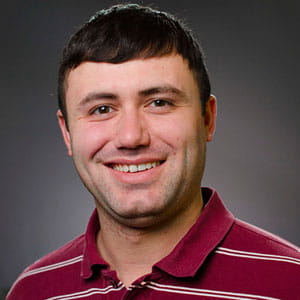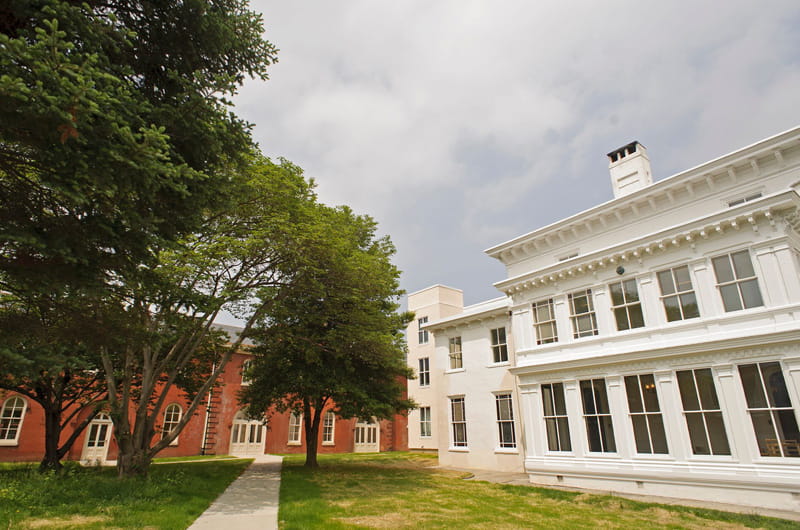The Anti-Parachuters: Dornsife Center Bonding With Drexel’s Neighbors
 By Frank Otto
By Frank Otto
Joanne Ferroni recalled the moment she felt the Dornsife Center for Neighborhood Partnerships had arrived.
During a grand opening event in June 2014, Ferroni, director of University and Community Partnerships, watched a group of Drexel students and young people from the neighborhoods the center serves, Powelton Village and Mantua, crowded around a pingpong table.
“Nobody cared where they lived. They were just having fun,” Ferroni said, smiling. “They were all just hanging out at this place that felt safe and comfortable.”
“I had one of those moments, too,” said Jennifer Britton, the Dornsife Center’s launch director. “We had a big turnout for astronomy night last month. Kids were laying on the ground together, using binoculars together, looking at the stars.”
A little more than a year after it officially opened, the Dornsife Center has become a positive force in the Mantua and Powelton Village neighborhoods. Standing in the heart of the federally designated Promise Zone designed to boost the local economy and improve education, the Dornsife Center is helping to accomplish just that.
“We work in a number of different areas,” said Lucy Kerman, PhD, vice provost of University and Community Partnerships. “Education is important to us. Public health is important to us. Economic opportunity is important to us.
Through programs that include workshops on anything from meal-planning to starting a business, local art exhibitions and community meetings, the Dornsife Center has established itself as the vanguard of Drexel President John A. Fry’s vision of “becoming the most civically engaged University in the United States.”
But it wasn’t that long ago that the Dornsife Center was just an idea.

An “Itchy” Beginning
A feasibility study involving for an “extension center” like Dornsife began in early 2012, involving Kerman and Drexel deans and faculty.
Before that plan even finished, local philanthropist Phil Lindy purchased what would become the Dornsife Center site. Kerman credited his “enthusiasm” with attracting a gift from David and Dana Dornsife to help establish the center.
Drexel formally acquired the site on the last day of February in 2013 and the Dornsife team literally moved in the next day, March 1, to begin offering programing.
“Pre-renovation, it was a little itchy,” Jennifer Britton, Dornsife’s launch director, said of the building’s interior with a grin.
Programing ran three days a week. They included initiatives that continue to this day, such as KEYSPOT computer classes, financial workshops and a community lawyering clinic run through the Kline School of Law.
But what became a defining part of the Dornsife Center originated right before the renovations began.
Having Dinner With the Neighborhood
“One of the things that became very clear was this was a community that didn’t want just programs and services: They wanted to talk,” Kerman said.
At the heart of Dornsife’s efforts is facilitating a civic dialogue between the residents of the neighborhoods surrounding Drexel and the University. It’s meant to be a two-way street, helping change perspectives of the neighborhoods toward Drexel and Drexel’s perspectives toward the neighborhoods.
In that spirit, Kerman and company conducted “Future Search,” a community-driven process that identified outreach goals and strengths that could be built upon. During one meeting, she realized there needed to be a way to keep the community talking.
“I said, ‘We want to keep talking. We should just have dinner together,’” Kerman said.
And so the monthly community dinner at the Dornsife Center was born.

The first was occurred in 2013, after Drexel took possession of the site and offered programs in the mansion, now the Lindy House. That first dinner was attended by about 65 residents; the next, 80. After the renovations and the Dornsife Center’s official opening in June 2014, attendance grew to its current 150–180 range, though a crowd of 230 attended dinner this June.
A tasty meal is provided, a local saxophonist recently began playing, and children get free books.
During one dinner, a local artist suggested staging a monthly show featuring art from the neighborhoods and Drexel.
“It’s really emblematic of the kind of work we’re doing,” Britton said. “We try to help foster these ideas that come organically from neighborhood participants and connect them to Drexel.”
CONNECTING DREXEL
During its first year, the goal was for the Dornsife Center to form connections with at least six academic units at Drexel. That goal was easily exceeded, featuring such highlights as the Kline School of Law’s “community lawyering clinic” and a dance program offered through the College of Arts and Sciences.
“When one faculty member wants to do something innovative and different, eventually all faculty members will want to do something innovative and different,” said Andrew Issa, extension agent at the Dornsife Center.

The new goal is to reach all academic programs in the University, but it doesn’t end there.
“In a lot of ways, this is a start-up within the University,” Ferroni said. “It’s really redefining extension in terms of what it means for Drexel. That is both the outward operations and the business processes.”
The Dornsife Center helps Drexel’s traditional operations jell better with the way things run in the surrounding communities.
Sarah Steltz, assistant director of University and Community Partnerships, said she measures success in jobs. She organized and helped run a “medical assistant pipeline” training program that has trained residents for jobs in the Drexel’s College of Medicine.
Steltz did a lot of résumé workshops in church basements and local schools before the Dornsife Center came to fruition. In one of those, she helped a woman set up a résumé for a job she got eventually. But when that woman began looking for a different one a little while later, she again crossed paths with Steltz.
After a meeting at the Dornsife Center with Steltz and getting some help from Drexel Human Resources, the woman got a job at Drexel.
“Over the course of years, developing long-term relationships with residents of the neighborhoods, they would come back to us and say, ‘I know you can help me.’” Steltz said.
Ultimately, it’s all about those connections at the Dornsife Center.
Ferroni described the notion of “parachuters,” the kind of outreach that just drops into a community with the best of intentions but without building the connections that provide knowledge of what those neighborhoods really want or need.
“We’re the opposite of the parachuters,” Ferroni said.
“Here we are in Mantua, in this welcoming space, actively working here with the community in a number of ways,” Kerman agreed. “The Dornsife Center really embodies Drexel’s vision for civic engagement and that’s what makes it so special.”
This article first appeared in the Summer 2015 edition of Drexel Quarterly.
In This Article
Drexel News is produced by
University Marketing and Communications.
